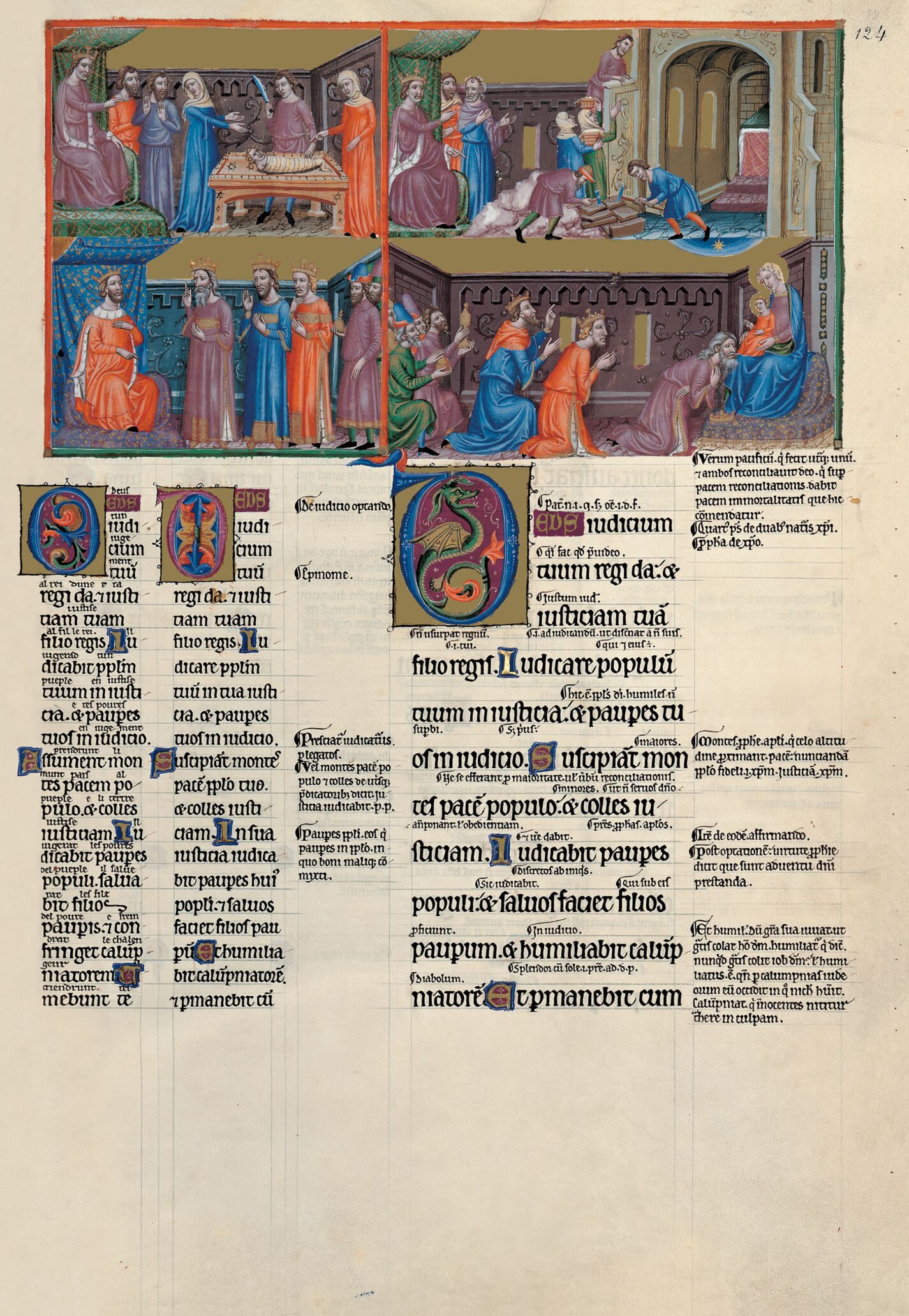Intended to accompany a psalm dedicated to Solomon, the wise king (v. 1, In Salomonem), the illustration on f. 124 is one of the most significant and interesting images in a book whose pictorial aspect avoids any superfluous or excessively repetitive elements. The Judgement of Solomon (I Reg 3: 16-28) opens this chapter, totally immersed in the description of the different forms of royalty. A new-born child is depicted on a wooden table in front of a man with a knife in his hand. On either side of the table are the two women fighting over the baby, with Salomon enthroned on the left alongside two middle-aged men. The king gives his verdict to the people waiting expectantly and one of the women seems to waive her claim to motherhood after hearing the king’s first words ordering the child to be cut in two. The psalm refers to the wisdom God endows monarchs with to enable them to be just (v. 2, Deus judicium tuum regi da: et justitiam tuam filio regis: Judicare populum tuum in justitia et pauperes tuos in judicio. // Give to the king thy judgment, O God, and to the king's son thy justice: To judge thy people with justice, and thy poor with judgment). Solomon is undeniably the biblical prototype of the wise king who acts fairly and returns the child to its true mother. The church fathers, however, also deemed Solomon, the son of David, to be the imperfect prefigure of Christ and Christ to be the true Solomon, i.e. the true king of justice (v. 7, Orietur in diebus ejus justitia, et abundantia pacis: donec auferatur luna. // In his days shall justice spring up, and abundance of peace, till the moon be taken away). It is not, therefore, strange that the theme of the Magi acknowledging Jesus as the king of heaven appears in the same miniature. Before analysing these episodes, which lead to the lower register, mention must be made of a new scene dedicated to the tale of Solomon. This is the construction of the temple (I Reg 5: 1-8) shown with the front already built and the altar set inside it. A builder is finishing the construction of one of the building’s buttresses whilst two women carry baskets of mortar to him and other people prepare blocks of stone in the foreground. The reign of this wise and devoted king, Solomon, over Israel prefigures the time when the Messiah will reign universally and for ever. The justice and peace of Solomon’s reign must, therefore, exemplify God’s wisdom and fairness.
Herod is visited by three kings garbed in brightly-coloured clothes. This scene enables two types of monarchs to be compared, since the former is considered to be a counterfigure of Solomon. Herod can be considered to be an evil king who destroys and persecutes the innocent. The Magi carry on to the place where they adore Jesus, represented upon the skirt of an enthroned mother. The Epiphany linked to the text of the Psalm (v. 10, Reges Tharsis, et insulae numera offerent: reges Arabum, et Saba dona adducent // The kings of Tharsis and the islands shall offer presents: the kings of the Arabians and of Saba shall bring gifts; and v. 11, Et adorabunt eum omnes reges terrae: omnes gentes servient ei: // And all kings of the earth shall adore him: all nations shall serve him) highlights the symbolic nature of this theme (Matt. 2). Firstly, the image of St Joseph is absent. Secondly, it situates the episode outside the narrative describing the arrival of the Magi and shows them kneeling in prayer. This emphasises the link with the psalm prophesying that all the kings of the earth would adore the true king of Israel, the true Solomon and offer him gifts (v. 10-11). Jesus is endowed with all the virtues previously cultivated by the monarch in the Old Testament, but perfected in their divine facet.
